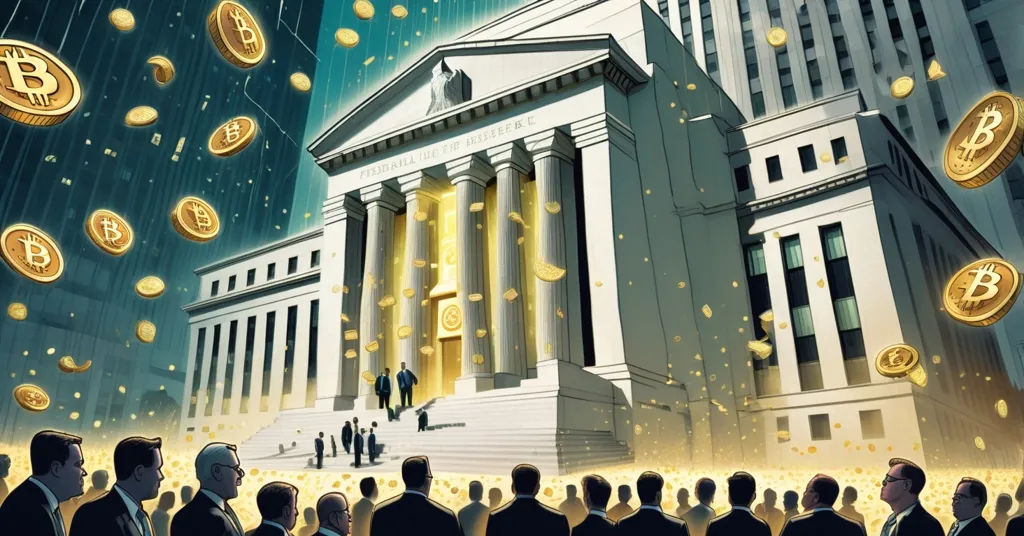Fed’s $29.4B Liquidity Injection: Will Bitcoin Rally or Stumble Amid Economic Strain?

Fed Injects $29.4 Billion into Markets: Bitcoin Traders Weigh the Fallout
On October 31, the US Federal Reserve unleashed a hefty $29.4 billion into the banking system through its Standing Repo Facility (SRF), marking the largest short-term liquidity injection since the 2020 pandemic chaos. This move, aimed at calming jittery money markets under strain from tighter policies and ballooning government debt, has Bitcoin traders buzzing about whether this could ignite another bull run—or if it’s merely a fleeting patch on a festering financial wound.
- Major Cash Infusion: Fed pumps $29.4B via SRF to stabilize short-term funding markets.
- Bitcoin on Watch: Past liquidity boosts fueled massive rallies, but will history repeat?
- Economic Red Flags: Recession warnings and Fed caution cast a shadow over optimism.
Here’s the breakdown of what’s happening and why it matters to the crypto crowd. The Fed didn’t just wake up and decide to play Santa Claus with this cash drop. This was a direct response to mounting stress in the repo market—a crucial yet often overlooked corner of finance where banks and institutions secure short-term loans by pawning off safe assets like Treasury securities for quick cash. Think of it as a high-stakes pawn shop for Wall Street: when it’s clogged, the whole system feels the pinch. Bank reserves had slumped to around $2.8 trillion before this move, and short-term funding rates—essentially the cost of borrowing overnight—had spiked in recent weeks, reminiscent of the 2019 repo meltdown when the Fed had to inject nearly half a trillion dollars over several months to keep things from imploding. For more details on this significant liquidity injection, check out the Fed’s $29.4B market intervention and its potential impact on Bitcoin traders.
The Standing Repo Facility, or SRF, is the Fed’s tool of choice here. It’s essentially a lender of last resort, offering overnight loans to banks against top-tier collateral to ensure they don’t run out of cash when the clock strikes midnight. This $29.4 billion injection temporarily beefed up reserves and dragged repo rates down, aiming to keep the financial gears grinding smoothly. For those new to these terms, “liquidity” here means the availability of cash or easily accessible funds in the system—when it dries up, markets choke, and everything from corporate loans to stock prices can take a hit.
Let’s be crystal clear: this isn’t a rerun of quantitative easing (QE), the Fed’s go-to during 2020 when it “printed money” by buying up bonds and permanently swollen its balance sheet to prop up markets. QE was like flooding the system with cash for the long haul, while this SRF operation is more like a quick loan—here today, gone tomorrow as the loans mature. It’s the difference between building a dam and tossing a bucket of water on a fire. But even a temporary splash can ripple through risk assets like Bitcoin, which famously soared from $7,000 in early 2020 to nearly $30,000 by December during the last major Fed liquidity binge. That kind of price action has crypto degens licking their chops, though we’d be fools to assume the same playbook applies in today’s choppy waters.
Financial System Under Strain: The Bigger Picture
The backdrop to this Fed move is a financial system still staggering from the hangover of pandemic-era easy money. Central banks globally, the Fed included, have been slamming on the brakes, yanking back the stimulus that kept markets buzzing during COVID while governments pile on debt to cover deficits. This one-two punch has sapped liquidity from the system, putting the repo market under pressure and raising eyebrows about whether the current setup can hold without cracking. Michiel Tukker, a senior rates strategist at ING, nailed the challenge ahead:
“Global money markets will all need to find their way in a world without excessive reserves. Although central banks now have many ways to pump in liquidity if needed, the question is whether such liquidity will reach those in need.”
Tukker’s warning is a gut check. Sure, the Fed can dump cash into the system, but if it doesn’t trickle down to the right spots—or worse, inflates another bubble or widens inequality—it’s just kicking the can down the road. Not everyone’s even convinced this $29.4 billion will cut it. Andy Constan, CEO and CIO of Damped Spring Advisors, threw some cold water on the hype:
“If and only if system-wide reserves are indeed suddenly scarce, more aggressive action by the Fed would be needed. It will all work itself out fine. If it doesn’t, rates will have to stay elevated, and the SRF will have to grow rapidly. Before that, it’s mostly worth ignoring.”
Constan’s “meh” vibe mirrors a broader unease in the markets. This cash boost might steady the ship for now, but it’s no fix for the deeper cracks. And the Fed’s own signals aren’t exactly screaming confidence. Chair Jerome Powell recently poured doubt on a December rate cut, blindsiding economists who’d bet the farm on lower rates. With monetary policy up in the air, both traditional finance and crypto markets are stuck in a fog of uncertainty.
Recession Fears and Fed Fallout: A Messy Economic Landscape
Zoom out further, and the economic picture gets even uglier. Treasury Secretary Scott Bessent didn’t hold back, sounding the alarm that chunks of the US economy are already in recession territory while blasting the Fed’s policies for screwing over certain sectors and demographics. His words were sharp:
“The Fed has caused a lot of distributional problems with their policies.”
Bessent’s jab isn’t just hot air. Tightening money supply to tame inflation often hits hardest at the little guy—small businesses get choked out of credit, job losses pile up in vulnerable industries, and wealth gaps yawn wider. If the Fed keeps rates jacked up without more relief, those economic hairline fractures could split wide open. For Bitcoin and cryptocurrencies, often pitched as a lifeboat in choppy fiat seas, this kind of dysfunction cuts both ways: it could drive folks to decentralized alternatives, or it might scare risk-averse investors into huddling with cash or gold instead.
Bitcoin and Crypto Markets: Will Fed’s $29.4B Spark a Rally?
So, what’s the read for Bitcoin traders? As the OG risk asset, Bitcoin tends to feast when liquidity flows and markets switch to “risk-on” mode. The 2020 bull run—where BTC skyrocketed over 300% amid QE madness—is the gold standard for this. Hell, even during the 2019 repo crisis, Bitcoin saw bursts of upward action as the Fed poured in cash, though nothing like the pandemic surge. But let’s not get carried away—this SRF injection is peanuts compared to QE, and the Fed’s tight-lipped stance on rate cuts hints they’re not about to crank open the money spigot. Plus, with global markets still wobbling post-COVID, there’s no guarantee this liquidity even nudges the retail FOMO that typically juices crypto prices.
Now, let’s play devil’s advocate with a bear case for Bitcoin amid this Fed caution. If economic fears deepen—think rising unemployment or a full-blown recession signal—investors might ditch high-risk plays like BTC for safer bets like bonds or gold, especially if regulatory uncertainty keeps institutions on the sidelines. Bitcoin’s no stranger to being snubbed as a “safe haven” when the chips are down, despite its decentralized swagger. And let’s not forget the 800-pound gorilla of high interest rates: if the Fed stays hawkish, borrowing costs could choke speculative investments across the board, crypto included.
On the flip side, if this liquidity shot does spark a risk-on wave, Bitcoin’s fixed supply and censorship-resistant ethos could shine as a middle finger to centralized mismanagement. I’m a Bitcoin maximalist through and through—it’s the purest escape from fiat nonsense—but I can’t ignore that altcoins and other blockchains like Ethereum have their place. If markets go bullish, Ethereum’s DeFi ecosystem or layer-2 solutions might snag speculative capital, innovating in ways Bitcoin doesn’t aim to. That said, tread carefully—most altcoins are digital tulips, pretty until they wilt, and macro news like this always brings out the scammers hyping “100x gems” on Telegram or YouTube. Don’t fall for that garbage; most of these “experts” couldn’t predict their own shadow.
Regulatory Risks and Decentralization’s Call
Another angle worth chewing on is the regulatory shadow lurking behind Fed moves. If tighter monetary policy sparks economic pain, governments might clamp down harder on crypto, fearing capital flight to decentralized systems as fiat falters. We’ve seen this dance before—post-2008, central banks and regulators got twitchy about anything threatening their grip. Bitcoin’s resilience, born from Satoshi Nakamoto’s vision of trustless money after that very crisis, is why it’s still king. Centralized interventions like this $29.4 billion drop only hammer home the need for a system that doesn’t bend to bureaucrats’ whims. If the Fed fumbles this balancing act, Bitcoin’s case as an untouchable alternative grows stronger—assuming regulators don’t smother it first.
What to Watch Next
As this unfolds, keep your eyes peeled for a few key triggers. Upcoming Fed meetings and economic data drops—like inflation figures or unemployment stats—could signal whether more liquidity or rate cuts are on the horizon. For Bitcoin, the next halving event looms as a potential catalyst, historically tightening supply just when macro conditions might push demand. And don’t sleep on regulatory chatter; any whiff of tighter crypto oversight tied to economic instability could spook markets faster than a Twitter rug pull.
Key Questions and Takeaways
- What drove the Federal Reserve to inject $29.4 billion into the markets?
The Fed reacted to stress in the repo market from dwindling bank reserves, spiking short-term funding rates, and pressures from tight monetary policies paired with rising government debt. - Could this liquidity injection trigger a Bitcoin price surge?
Past Fed actions, like 2020’s QE, saw Bitcoin rocket from $7,000 to $30,000, but this temporary SRF move isn’t as potent, so any rally hinges on broader market risk appetite. - How does this differ from quantitative easing (QE), and why does it matter for crypto?
QE permanently boosts money supply with asset purchases, driving past Bitcoin bull runs, while SRF is a short-term loan, likely limiting sustained crypto speculation unless sentiment shifts hard. - Can economic uncertainty from Fed policies boost Bitcoin adoption?
Recession fears and Fed policy critiques could nudge investors toward Bitcoin as a decentralized hedge against fiat flaws, though risk aversion might steer them to gold or cash instead. - What risks does crypto face if the Fed doesn’t ease further?
Without rate cuts or added liquidity, high interest rates could deepen economic pain, pushing investors from risk assets like Bitcoin and altcoins to safer havens, stalling market momentum. - Will altcoins benefit from the Fed’s liquidity boost?
Ethereum and DeFi might draw speculative cash if liquidity fuels risk-on vibes, but beware—many altcoins lack substance, and scammers exploit macro news to peddle worthless tokens.
The Fed’s high-wire act between stabilizing markets and dodging inflation traps will be pivotal in the coming weeks. For Bitcoin traders, the dream of another liquidity-fueled rally glimmers, but it’s dimmed by a cautious central bank and a shaky economic foundation. If the Fed botches this, we’re not just looking at market hiccups—we could be staring at a full-blown financial dumpster fire. But hey, if that happens, Bitcoin’s decentralized middle finger to centralized screw-ups might finally steal the show. Stay vigilant, stack sats, and don’t swallow the hype—whether it’s Wall Street suits or some random “analyst” on X promising $100K BTC by New Year’s. We’re playing the long game, not chasing pump-and-dump fantasies.



